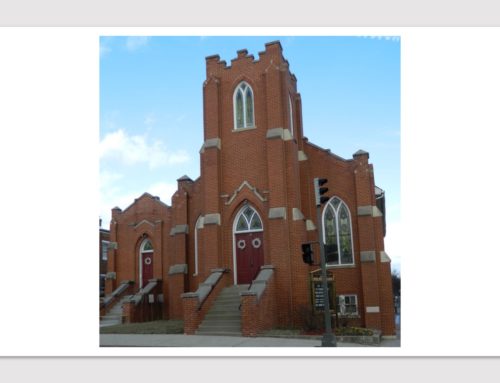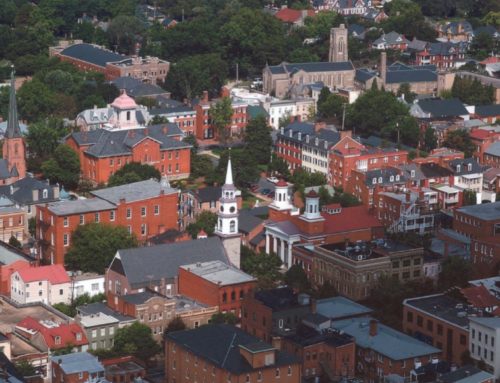Excerpt from the Frederick News-Post:
The days of Frederick’s former Birely Tannery building are officially numbered after a Historic Preservation Commission vote Thursday.
Demolition, however, is still many months, many plan approvals and many historic mitigation efforts away.
Much to the disappointment of passionate historic preservation advocates, the city’s Historic Preservation Commission voted 6-1 Thursday to allow demolition of the historic downtown building for construction of a proposed downtown hotel and conference center.
The motion, which Chairman Dan Lawton made, came with a set of conditions that included requiring an approved replacement plan for the building and the site, among others.
Commissioner Carrie Albee was the lone opposition vote. She explained that while she agreed with the overall decision, she did not agree with a condition that said the demolition should be approved because it is in the best interest of residents.
The commissioners’ vote concurred with the staff report associated with the request, which said employees determined that “the structure is a deterrent to a major improvement program that will be of substantial benefit to the City subject to the approval and permit application for a replacement plan.”
Lawton said it was difficult for him to make the motion Thursday and hates that the building will be demolished, but he admitted that few original historic elements exist there today.
“I came to back to this commission to be a strong advocate for historic preservation, and I personally feel that I am one, and it’s painful to make this motion,” he said. “But I also promised myself, there’s room in preservation for common sense. … We need to temper our idealism in rare occasions, and this is one of them.”
The demolition request stems from plans to construct a multimillion-dollar 180-room hotel and 20,000-square-foot conference center at 200-212 E. Patrick St. The project is set to come to fruition with both public and private dollars.
The HPC determined in July that the early 20th-century tannery building and surrounding archaeological site are contributing resources to the Frederick Town Historic District, thus halting immediate demolition approval.
Thursday’s approval means the project can now move on to the site plan phase.
Pete Plamondon Jr., co-president of developer Plamondon Hospitality Partners, said Thursday after the vote that he looks forward to the next phase of the project, which is a workshop with the historic preservation commissioners to finalize the design.
“This is the exciting part,” he said. “Now we can make history come alive with the design process.”
The commissioners’ decision Thursday came after two hours of public testimony and an hour and a half of discussion at a public hearing. The hearing capped off hours of discussion over the past two months in four workshops addressing the details of the request and the proposed project.
Of the 39 speakers at Thursday’s hearing, 23 spoke in favor of the demolition while 16 spoke against it. Not everyone who attended the hearing spoke publicly.
Many of those who spoke in favor of the demolition over the course of the process represented organizations such as East Frederick Rising, the Downtown Frederick Partnership, Fort Detrick Alliance and Frederick County Chamber of Commerce. Other residents and members of the local business and tourism industries also pushed for the demolition.
They discussed Frederick’s need for a downtown hotel and pointed out that no one has made any effort to revitalize the building or even mentioned it before it was slated for demolition.
“If the building was structurally useful or beautiful, someone would have grabbed that thing and gone with it. No one is appreciating that boarded-up building,” said Carley Ogden, co-owner of Attaboy Beer, during the public comment period.
The commenters who spoke against the demolition included several historic preservation advocates and researchers as well as residents who do not want to see the city’s history lost. A certified archaeologist and others who have done a great deal of research about the history of the site also made last-ditch efforts to save the building.
While most of the commenters said they overall are in favor of a downtown hotel, several criticized the developer’s site choice and what they perceive as a lack of effort to incorporate the tannery building into the project plans.
For Gil House, a city native and self-proclaimed amateur historian, tearing down the tannery building takes away a chance to preserve the city’s history in a unique way.
“This building doesn’t look like much, but neither did the current visitors center or Shab Row,” he said.
Plamondon and architects with Peter Fillat Architects and Bates Architects presented the project plans in the previous workshops. The presentations showed their efforts to incorporate the tannery building into the project plans and some examples of how they plan to incorporate the historic elements of the site and the tanning industry into the final construction.
The proposed design includes demolition of the tannery building but incorporates rehabilitation of the old Frederick Trolley building, which most recently housed The Frederick News-Post.
The developers, architects and other project partners were tasked with proving demolition of the tannery as the only logical way to construct the hotel at that site. They were also required to prove that all possible alternatives to preservation have been exhausted and to provide an alternative plan for preserving the historic elements of the site.
The Birely Tannery was established in 1830 and operated until 1952. The current building was constructed in 1909.
In 1955, the building was repurposed into a poultry plant and all remaining accessory structures were demolished, but the main tannery building was retained and adaptively reused, according to records summarized in the staff report.
The building has been classified as the last tannery facility in Maryland. At one time, Frederick was known as the hub of the industry with as many as eight tanneries in operation in the early 20th century, according to the records.
The building has also sustained damage over the years, including fires that destroyed significant historic elements.



